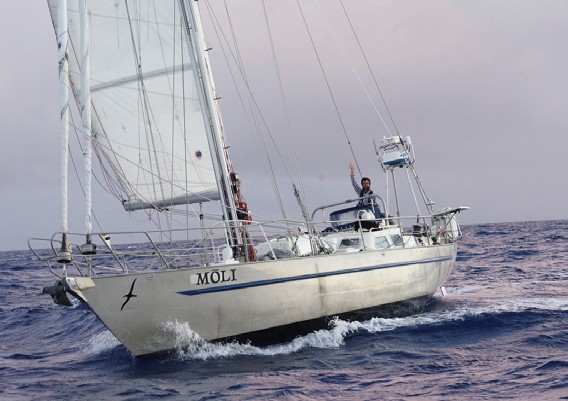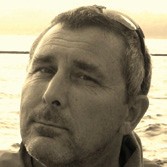By Joe Cooper
I am sitting in an armchair, a nice, thick, plush comfy one, looking out through the glass doors of the Clan Cottage in Michigan on Lake Huron. It is blowing hard, 30 plus, from the northeast, for close to 24 hours. The lake is that particular color of pewter slate grey that big water gets on days like this. It is all grey but with slight variation, in shade, only a few Pantone numbers different, yet the differences are visible to the eye. All the way to the near razor sharp horizon, this greyness is flecked with white. Farthest out there are little drops of white scattered here and there. In the middle distance, the dots manifest into obvious breaking whitecaps. Closer inshore the waves, something around four feet at the biggest, are breaking on the outside sandbars and the white gashes are long and thickish. The whole scene looks like Jackson Pollock warming up.
Although it is mid-afternoon and still daylight, I have cleaned off, filled and lit one of the cottage’s Dietz Hurricane lamps. I like – love – the look, feel and smell of these simple lamps. We have a couple on the Ranger that are remnants of long distant memories of sailing adventures with my dad. The view out the window of a gray, not dark yet, and stormy day and the light air of the burning kero lamp plops me quite neatly in the DeLorean, back to about 1961 or so.
Growing up sailing really spoils one for life, and the idea of sailing as adventure really did it for me. I sailed with my dad on a succession of modest boats. Undeterred by LOA, we would sail all over the countryside in a place called Broken Bay, 30 miles north of Sydney. We would anchor, and I would go scrambling around in the adjacent bush, or spend hours sailing my Sabot around the bays, inlets and creeks. I would go ashore, eat my sammies and sail off again. I can remember vividly finishing my adventurous day of exploring, being curled up in my blankets reading by the light of the ‘kero’ hurricane lamp a Swallows and Amazons, while dad relaxed, smoked, sipped his scotch, maybe sketching and listening to something on the BBC shortwave radio.
I was fascinated by the early pioneers of global sailing and the great adventures these guys were having. I followed and read everything about Robin Knox-Johnston, Francis Chichester, Alec Rose, Commander Bill King, and especially the Frenchman and legendary soloist, Bernard Moitessier. It was apparent that there was a lot more adventure to this sailing than simply banging around the bay, even the way I did it.
In reality, I had no chance for a normal life. I went to primary school across a sports field from Sydney Harbor and could see boats out sailing almost all the time. I remember watching the Chilean Tall Ship Esmeralda on a visit to Sydney, sailing down the harbor before a freshening nor’easter looking like a Montague Dawson painting.
I went to high school in Vaucluse, a Sydney suburb, built on the summit of the high cliffs defending the southern approaches to Sydney Harbor. The school’s graphic was of the Macquarie lighthouse, said lighthouse being the first light of approach to Sydney, sited atop these 270-foot high cliffs. On particularly stormy days one could hear the crash, a primal earthly sound of massive forces colliding as the 25 to 30 or more-foot swell, the result of a winter gale, thundered against the boulder strewn base of the sandstone cliffs.
Depending on which classroom I was in, I had a 200-degree view of the Western Tasman Sea out across the vast ocean to the far horizon, which from 300-odd feet is, well, a long way. In the classrooms on the other side of the school I had a similar view for 60 miles across Sydney Harbor, downtown, across to Manly in the north end of the harbor across the heads, the iconic Harbor Bridge spanning the river, up to the foothills of the Blue Mountains to the west of Sydney. I attribute my poor performance in formal education to this harsh environment in which I was raised. The chalk and dusters, aimed at me by annoyed teachers tying to pull my gaze back to the blackboard from out the window wondering about the rest of the world, did not help either.
On the other hand, such an aerie from which to view the storms and calms, the wildly differing colors, sizes and shapes of the cloud formations, the rain squalls, and the freighters muscling their way through the pewter-colored ocean and bursting through the bright white, cresting breakers in a mid-July storm managed to fire in me what I have decided is a, or perhaps the fundamental question for me, and possibly mankind including the women. ‘What is over there?’ There being the other side of the horizon. It is possible that if we were not coded in some fashion to be driven to ask – and act on – this question, well we might all still be in the trees.
Adventures are by definition something outside the ordinary, routine, mundane, and that which we are accustomed too. Circumnavigating the globe in a sailing boat thus qualifies. ‘But why?’ is the common question. ‘It seemed like a good idea (at the time),’ ‘I have always wanted to’ or the quest for some glory, or perhaps the most famous may be what British mountaineer George Mallory is reported to have said in response as to why he wanted to climb Everest: ‘Because it’s there.’
The list of those who have circumnavigated the globe is small. The number of those who have gone across the equator to do it is smaller, and those who have done it alone is smaller still. It might be argued that these days there is something of a furrow being dug across those lonely, rolling mountains of water, inhabited by the wandering albatross, the unchallenged masters and mistresses of the loneliest place on the planet, the gray and vast wastes known as the Southern Ocean.
This urge for adventure appears to be shared by one Randall Reeves who, as you are reading this column, ought to be around 20 days at sea from San Francisco, bound towards, well San Francisco. Since the ‘usual track,’ even the wrong-way one, is pretty well worn, Mr. Reeves is proposing to sail a course around the Americas, in a figure eight pattern.
 His track is south from San Francisco, Cape Horn to port and Antarctica to starboard, back around the Horn crossing his outbound track and then South America to port up through the Northwest Passage and back to San Francisco, hence the moniker Figure 8 Voyage.
His track is south from San Francisco, Cape Horn to port and Antarctica to starboard, back around the Horn crossing his outbound track and then South America to port up through the Northwest Passage and back to San Francisco, hence the moniker Figure 8 Voyage.
Randall Reeves has embarked on a first-ever circumnavigation of both the American and Antarctic continents in one season. The route will pass through all of the world’s oceans, approach both poles, and round Cape Horn twice. No one has done this before. No one has even tried. © Kim Kirch/kimkirch.com
The clutter of boats in the Southern Ocean these days is a far cry from ‘the old days,’ hence Randall’s unorthodox track. His vessel of choice is a 45-foot aluminum boat built in 1989 in Germany. The pitch on his website (figure8voyage.com) speaks to the never before done aspect of his passage. Well, that is always a good solid keel on which to build one’s adventure, classic in fact. The boat’s original owners circumnavigated the Americas and the next owner did the circumnavigation. Randall’s plan is to combine both those tracks and so I reckon double his adventure quotient and at the same time have the never done factor. The interesting part to me is there is no ‘Mission.’ There is no speed record, no ‘Save the ‘fill-in-the-blanks’, no higher scientific goal, no school education aspect. Randall seems to be simply going for a sail simply for the sake of going sailing and having an adventure.
There are probably reasons as numerous and varied as the people who do it. Randall’s response when I posed the question ‘Why?’ was a chuckle, closely followed by my answering for him: ‘There may not be an answer to the why…right, I get it.’ We talked on this for a bit and we got some VMG towards an answer of sorts. He told me that sometimes he is at, say a party and upon hearing what he is doing people, usually aghast, naturally ask why, and he responds, ‘If you had the opportunity to visit another planet, would you go? While they look mystified he continues…‘Being in the ocean is similar to being another planet. You are captive in a small module, in a tremendously hostile environment, everything more or less devolves from your responses to the next event, the likelihood of help is either not easy or slim depending on where you are, and it is beautiful. No two days are the same, sometimes two hours brings vast changes in the colors, the conditions and so how you feel.’ There is solitude, time for fundamental reflection, communing with your inner self even.
If we accept that the output of adventure is experience, reflection, introspection, fear, joy, the mundane, the beautiful and the entire kit bag of human emotion and experience, the meaning of life, some sense of ourselves to, or for, ourselves, time – lots – for thinking, thinking of the questions, for they are always more important than the answers, then six months at sea alone is a pretty good way to figure it eight.
 Australian born, Joe ‘Coop’ Cooper stayed in the US after the 1980 America’s Cup where he was the boat captain and sailed as Grinder/Sewer-man on Australia. His whole career has focused on sailing, especially the short-handed aspects of it. He lives in Middletown, RI where he coaches, consults and writes on his blog, joecoopersailing.com, when not paying attention to his wife, teenage son, dog, two cats and several, mainly small, boats.
Australian born, Joe ‘Coop’ Cooper stayed in the US after the 1980 America’s Cup where he was the boat captain and sailed as Grinder/Sewer-man on Australia. His whole career has focused on sailing, especially the short-handed aspects of it. He lives in Middletown, RI where he coaches, consults and writes on his blog, joecoopersailing.com, when not paying attention to his wife, teenage son, dog, two cats and several, mainly small, boats.




